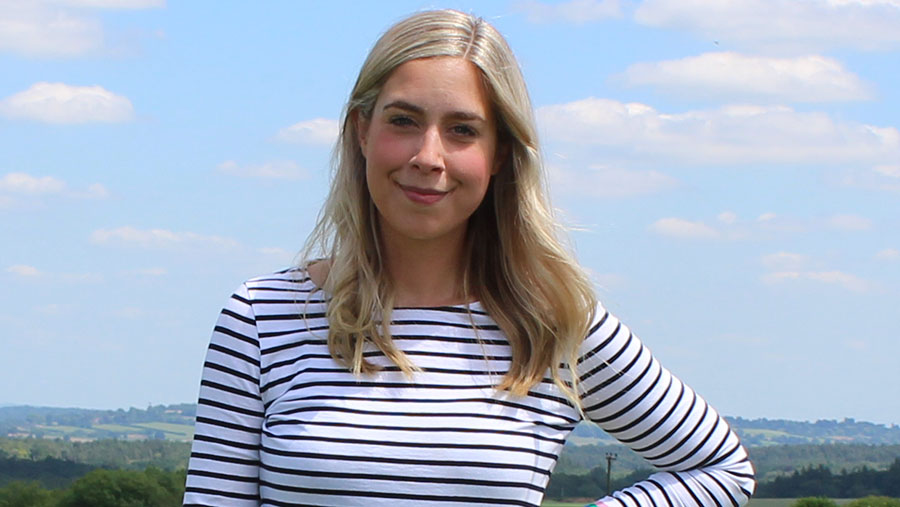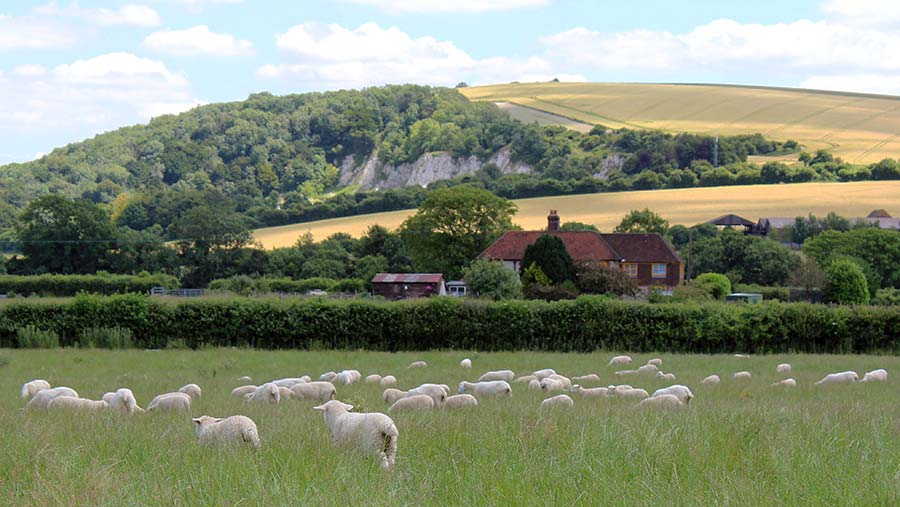The girl who ditched a marketing career to be a sheep farmer
 © Oli Hill/RBI
© Oli Hill/RBI Boasting an advertising and marketing background combined with zero farming experience, Laura Hodgkins doesn’t sound like the most obvious candidate to take on a sizeable farm tenancy with 2,000 breeding ewes.
However, about two years ago she handed in her notice at work, triggering the start of a life-changing journey from London-based project manager to hardened sheep farmer complete with farm grime under her fingernails.
Along with her husband Andy, Laura farms about 280ha of lush pasture enveloping Cocking Hill Farm on the edge of the picture-perfect South Downs National Park in West Sussex.
See also: Farmer-turned-race engineer gears up for Le Mans 24-hour race
After falling for this ex-dairy unit run formerly by the Cowdray Estate, this enterprising young couple took the plunge and in the summer of 2016 applied for a 12-year tenancy on offer from the estate.
They put forward an ambitious vision of introducing a flock of hardy New Zealand Romneys to the South Downs, operating a low-cost, low-input system with year-round rotational grazing.
“One Friday I was having drinks with friends in London and Andy called to say we got the tenancy,” 31-year-old Laura recalls.
“It’s not uncommon for people to apply for 10 tenancies before getting any luck, so we were really happy to get this one on our first go as a couple.
“My boss’s eyes nearly popped out of her head when I told her that I was giving it all up to be a farmer.”
The pair moved into their freshly renovated farm cottage that October, bringing with them their starter flock taken from 32-year-old Andy’s family farm just 15 miles down the road.
They’ve replicated the extensive mob grazing system run by Andy’s parents, achieving a high health status for their flock, meaning they can export breeding stock to farms across Europe.
https://www.instagram.com/p/Bjp7TXqgTVf/?utm_source=ig_web_copy_link
Shearling rams and ewes are sold as quality breeding stock and fat lambs are finished on a mix of grass and herb leys without concentrate feed, staying true to their ultra-low cost mantra.
Laura and Andy have been working tirelessly to replace some 25,000m of cattle fencing to make the fields sheep-proof, meaning the pair are no strangers to late night reports of escapees and reinforcing boundaries.
In at the deep end
Having only occasionally helped Andy and his parents out on the family farm, Laura found herself plunged straight into one of the toughest and longest seasons in the the farming calendar – winter.
“Starting out on those dark, wet days with limited hours of daylight was hard work. A few months in and my old office looked pretty good,” she recalls.
“But it actually turned out to be a blessing in disguise because things could only get easier.”
She started her blog, Girl About The Farm, partly to help her through the early days but also to keep intrigued family members and friends updated on what exactly she had got herself into.
“From a new entrant’s perspective I’m not your typical farmer, so I found other blogs helped me to meet other people and feel better when I was wondering, ‘do other people feel the same way or worry about the same things that I do?’,” she says.
https://www.instagram.com/p/Bldk0_SgzB6/?utm_source=ig_web_copy_link
A quick flick through her blog and you’ll know that it is aimed less towards audiences with a deep technical knowledge of agriculture and is more focused on catering for those with limited understanding of farming – much like Laura herself in the beginning.
She freely admits that her target audience is basically the same as that of BBC One’s Countryfile and for that reason she tends to steer clear of more controversial farming topics.
See also: Shropshire dairy farmer on his emotional aid work overseas
Her farming and lifestyle blog covers many bases, offering something for everyone, from informative FAQs on lambing and shearing to ways farmers can achieve a better work-life balance and avoid getting stuck in a rut of depression.
Insta-famous
Building a strong following on social media is where Laura’s advertising and marketing skills come into their own. Although she’s on Twitter, Snapchat and Pinterest, the most important platform for her is Instagram.
Fast approaching 7,000 followers, her Girl About The Farm Instagram account is awash with gorgeous photos posted almost daily.
“Instagram is quick and easy to do on the go – think of it as a photo-led blog,” she explains. “It’s easy for me because it’s image-led content and that works really well for us here on the beautiful South Downs.
“My blog is actually second to my Instagram account – [the latter] drives everything because it’s my vehicle for letting people know about new stuff on my blog. Without Instagram I wouldn’t have much of a following.”
https://www.instagram.com/p/Bi4lV-xgE6x/?taken-by=girlaboutthefarm
“As the number of followers grow, you start to build a direct link with the consumer. As farmers we generally have very little contact with our consumers, so we are looking more at getting that direct link because we are very proud of what we do here.”
Laura’s tips for success on Instagram
- It’s important to know from the start who you’re catering for when posting to Instagram.
- Once you’ve identified your audience and know what they like, think about how you’ll use stories and posts and be sure you understand the difference between the two.
- Laura treats stories as more throwaway because they are only visible for 24 hours. “My stories are very of-the-moment, and I can get a lot more of my personality across,” she says. “Stories are more representative of my daily life working on the farm. The target audience for these is more young farmers, ag students and those from farming families.”
- Posts are more carefully crafted and generally tend to showcase the beauty of the farm and the country living ‘good life’ and get better engagement from the same crowd who follow her blog.
- Laura uses her iPhone 7 Plus to take about 90% of all the photos she posts on Instagram, with the occasional shot taken on her DSLR camera – although there’s no real need to ever use anything other than her iPhone’s camera.
- Hashtags are the main way users will find your posts if they don’t already follow you and this will help to grow a following more rapidly. Keep hashtags tailored to the post subject and consider who you want to see it. Some hashtags are common to most farming-related posts – #countrylife, #countryblogger, #britishfarming and #farm365. Do your homework by seeing what hashtags other farming accounts use and don’t be too literal.
- Laura tends to write extended captions for most of the images that she posts – these are usually four or five sentences, which help to give context and an explanation of what the image represents.
- If you’re planning on setting up a brand as Laura has done, her advice is to set up all social media accounts at the same time to grow them all equally, but make sure you know which platforms are used most commonly by your chosen audience.
No going back
Given the Brexit-induced uncertainty looming large over our farmers, the couple are looking seriously at diversifications that will take their early success with public engagement to the next level.
They plan to make the most of the farm’s relatively close proximity to the capital and other affluent areas such as Guildford, plus the fact that the popular South Downs Way snakes through part of the farm and is rife with ramblers.

© Oli Hill/RBI
“We’re in the public eye a lot of the time here and we aim to be good ambassadors for the Cowdray Estate as its tenants,” says Laura.
It’s humbling to take in how far Laura has come in a just a couple of years, building her knowledge of sheep farming while putting her skills in marketing to great use, bringing a rare strength that is set to become even more crucial to farm businesses in the future.
“I do miss being able to meet up with people easily after work – now going out with friends is a bit of an event, which needs prior planning and I don’t get my weekends off,” she says.
“Of course there are times when I feel like I can’t do this any more, but that’s farming – one minute you’re the most stressed you’ve ever been and then you’re fine. I certainly wouldn’t go back to my previous career now.”
